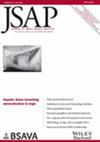Effects of left vagus nerve retraction on post-operative unilateral left-sided laryngeal paralysis following surgical closure of patent ductus arteriosus in dogs
Abstract
Objectives
This study was aimed at determining the incidence of left-sided laryngeal paralysis in dogs that underwent patent ductus arteriosus open surgical ligation and at identifying whether left vagus nerve retraction during surgery might be a risk factor for post-operative left-sided laryngeal paralysis development.
Materials and Methods
Medical records for dogs referred to our clinic for surgical patent ductus arteriosus closure between July 2012 and May 2022 were reviewed. The inclusion criteria were echocardiographic diagnosis of left-to-right shunting patent ductus arteriosus, standard surgical ligation of the patent ductus arteriosus, short-term follow-up at 30 days and long-term follow-up for at least 365 days.
Results
Of the 40 dogs included, left vagus nerve retraction was performed during surgical dissection in 25 dogs. All dogs survived the surgery, with full closure of the patent ductus arteriosus in 100% of cases. The overall incidence of post-operative left-sided laryngeal paralysis was 12.5%. Heavier weight was significantly associated with a greater risk of left-sided laryngeal paralysis after surgery (odds ratio = 1.19; P = 0.044). Left vagus nerve retraction during surgery was not significantly associated with left-sided laryngeal paralysis risk (P = 0.996). No dogs required arytenoid lateralisation. In long-term follow-up, 37/40 dogs remained alive at an average of 1874 days after surgery.
Clinical Significance
Endoscopic evaluation of laryngeal function after surgical patent ductus arteriosus ligation is recommended when dogs present with inspiratory stridor, vocal changes, exercise intolerance or regurgitation post-operatively.

 求助内容:
求助内容: 应助结果提醒方式:
应助结果提醒方式:


